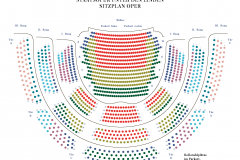The Silent Woman
Mo | Tu | We | Th | Fr | Sa | Su |
COMIC OPERA IN THREE ACTS (1935)
MUSIC FROM Richard Strauss
TEXT FROM Stefan Zweig after Ben Jonson
In the early 1930s, for Richard Strauss — approaching 70 — it was an auspicious moment when Stefan Zweig, a renowned author known for his artful, profound novels and plays, proposed writing a new libretto. In a mutually inspiring collaboration, they created a truly “comic opera” based on a play by Ben Jonson from the Shakespeare period filled not only with striking characters, tempo, and wit, but profound reflection as well. “The opera is a perfect, but perhaps for the twenty-first century,” according to Strauss himself, who in a difficult, dark time created a work of creative compositional virtuosity and a relaxed sense of humor, a story of people longing for rest or who lose themselves in busyness. This will be director Jan Philipp Gloger’s debut and it will be Christian Thielemann’s first new production as general music director, a position once held by Strauss himself.
Synopsis
Setting: a room in Sir Morosus' house in a London suburb, around 1760.
Act 1
Retired naval captain Sir John Morosus is very intolerant of noise after having survived an explosion on his ship. For some years he has been retired and living with his housekeeper who looks after him well, although he finds her chatter annoying. His barber arrives and after an argument with the housekeeper that disturbs Morosus, tries to calm down the Captain. He tells Captain Morosus that he should take a quiet young woman. At first Morosus is skeptical: is not a quiet woman like sea without salt? The barber assures him that he knows a dozen "quiet doves" who would want to marry an honorable man like him. Morosus starts to warm to the idea, when suddenly his long-lost nephew Henry appears. He is warmly welcomed: Morosus dismisses the idea of marriage and makes Henry his "son and heir". However, when Henry reveals that he, his wife Aminta and his friends are an opera troupe, Morosus reacts in horror particularly to the idea that Aminta is an opera singer. The captain throws the opera troupe out of his house and disinherits Henry. He instructs the barber to seek a silent woman for him to be his wife the very next day and then retires to bed. The barber reveals to the troupe how rich Morosus is ("sixty, seventy thousand pounds"). Aminta says that she will not come between Henry and his inheritance and offers to leave Henry. Henry tells Aminta that he cannot live without her even if it means losing his inheritance. The Barber has an idea. What if the opera troupe acts out a drama in which the ladies of the troupe have the roles of the prospective brides and they enact a sham marriage? The Bride will then become very noisy and they will act out the divorce. Henry likes the idea: his uncle has insulted the troupe, so they will show him their abilities "and who is the fool shall be fooled". The scene ends with a glorious celebration of the wonderful plan.
Act 2
The housekeeper helps Morosus put on his finest dress-jacket. The Barber arrives and reassures the captain that he has arranged all of the details for the marriage ceremony. He then introduces the three potential brides. Carlotta stands forward acting as "Katherine" a simple country girl. Morosus is not keen: she has spent too much time with calves and become one herself. The Barber next introduces Isotta, playing the role of noble lady educated in a wide range of subjects. Morosus is not impressed by this and is suspicious of her ability to play the lute. Lastly, the Barber introduces Aminta acting as the modest and shy "Timidia". Morosus is quite captivated by "Timidia" and tells the barber "she is the one" and orders him to get the priest and notary for the marriage ceremony. Vanuzzi and Morbio act out the roles of parson and notary and the sham marriage takes place. Farfallo arrives with the rest of the troupe playing sailors who have come to celebrate the marriage, making a lot of noise. Morosus is driven mad by the noise and ejects them from the house. Aminta has become quite touched by the genuine love of Morosus, who wants to know why she seems troubled. Eventually, she has to carry out the barber’s plan and starts shouting at Morosus in feigned anger. She wreaks havoc in the house pulling down the curtains and throws some of the captains most precious possessions onto the floor ("away with this junk"). Then Henry arrives to save the day. He forcefully deals with Timidia, and assures his uncle that he will deal with everything. A grateful Morosus thanks Henry: he has survived many sea battles and hurricanes, but would not stand a chance against someone like Timidia. Henry sends the captain off to bed, where he dozes off. Now alone, Aminta and Henry then sing of their love for each other. Morosus awakes and calls down: "is everything all right?" "Yes", says Henry. Morosus falls back asleep with a deep sigh which counterpoints with Amita’s sighs of love as the scene closes.
Act 3
The next day Aminta has hired "craftsmen" who make noises as they hammer nails and slam doors. There is a noisy parrot who squawks. In addition, she has appointed a pianist (Farfallo) and a singing teacher (Henry) who practice Monteverdi’s "L’incoronaziane di Poppea" with her. The captain appears and is completely devastated. The Barber walks in and introduces a "Lord Chief Justice" (Vanuzzi) and "Two lawyers" (Morbio and Farfallo) who discuss the prospective divorce. However, "Timidia" contests the divorce and they reject every case for divorce. The barber argues that she has had relations before the marriage to Sir John and the two "honorable ladies" (Isotta and Carlotta) attest to this. The Barber also introduces a "witness" (Henry) who attests that he has had carnal relations with Timidia. Morosus scents victory and is about to celebrate when the lawyers raise a further barrier to divorce: the marriage agreement did not stipulate the virginity of the bride, so "you will have to keep her now". Morosus is close to a nervous breakdown. Henry calls an end to the charade and all stop acting and all are revealed as their true characters. Aminta asks the captain's pardon. After the captain realizes he has been fooled his initial anger turns to laughter as he sees the funny side of a troupe of actors outwitting him. Overjoyed, he makes peace with the troupe of actors as they leave and gives his blessing to Henry and Aminta’s union and proclaims Henry again as his heir. He is pleased with himself and the world after his narrow escape and has at last found the peace he has longed for. The opera ends with a monologue of Morosus: " A rare delight it is to find a silent, beautiful girl, but it is more delightful when she belongs to another man".
Program and cast
Language: In german language with german and english surtitles
Recommended age: 14 years and older
Insight before the premiere on 14th july 2025
CAST
MUSICAL DIRECTOR: Christian Thielemann
DIRECTOR: Jan Philipp Gloger
SET DESIGN: Ben Baur
COSTUMES: Justina Klimczyk
CHORUS MASTER: Dani Juris
DRAMATURGY: Detlef Giese
SIR MOROSUS: Peter Rose
SEINE HAUSHÄLTERIN: Iris Vermillion
BARBIER SCHNEIDEBART: Samuel Hasselhorn
HENRY MOROSUS: Siyabonga Maqungo
AMINTA, SEINE GATTIN: Brenda Rae
ISOTTA: Evelin Novak
CARLOTTA: Rebecka Wallroth
MORBIO: Dionysios Avgerinos
VANUZZI: Manuel Winckhler
FARFALLO: Friedrich Hamel
STAATSOPERNCHOR
STAATSKAPELLE BERLIN
State Opera Unter den Linden
Staatsoper Unter den Linden is one of Berlin's most prestigious opera houses, with a rich history and significant cultural impact.
History:
The Staatsoper Unter den Linden was originally built between 1741 and 1743, under the direction of architect Georg Wenzeslaus von Knobelsdorff. It was commissioned by Frederick II of Prussia and was initially named the Königliche Oper (Royal Opera). The opera house has undergone several renovations and reconstructions, notably after World War II damage. It reopened in 1984, following a major renovation.
Construction:
The original design was characterized by its Baroque style, featuring an elegant façade and a grand entrance. The building was reconstructed in the 1950s and 1980s, maintaining its classical exterior while modernizing the interior. The façade features a classic portico with six Corinthian columns and a prominent central pediment.
Interior:
The interior is known for its opulent and classical design. The auditorium is renowned for its acoustics and grandeur, with luxurious velvet seats and elaborate decorations. The stage and seating areas have been updated to meet modern performance standards while preserving historical aesthetics.
Concerts and Performances:
The Staatsoper Unter den Linden hosts a variety of performances, including operas, orchestral concerts, and ballet. It is home to the Staatskapelle Berlin, one of Germany's leading orchestras. The opera house is celebrated for its high-quality productions and its role in Berlin’s vibrant cultural scene.
JOURNEY
The Staatsoper Unter den Linden has completely barrier-free access due to its excellent public transport connections.
ADDRESS: Unter den Linden 7; 10117 Berlin
SUBURBAN RAILWAY
S+U Friedrichstraße (S1, S2, S5, S7, S25, S75)
SUBWAY
Hausvogteiplatz (U2)
Museumsinsel (U5)
Stadtmitte (U2, U6)
Unter den Linden (U5, U6)
BUS
Staatsoper (100, 245, 300)
Unter den Linden/Friedrichstraße (100, 147, 245, 300, N6)
PARKING
Q-PARK parking garage Unter den Linden/Staatsoper
Bebelplatz, 10117 Berlin
There are five electric charging stations in the parking garage. Further information can be found here.
The underground car park on Bebelplatz offers disabled parking spaces and direct access to the opera house. On entering the car park between 5.30pm and 11.30pm, the maximum parking fee is €7. To use this tariff, enter your parking ticket in one of the pay machines and the message »Theatertarif« will appear on the display. Please note that it is not possible to use the tariff if you enter the car park before 5.30pm. so it will not be shown on the display. TIP: If you pay the theatre tariff at the pay machine before the event, you can avoid unnecessary waiting after the show.

 EN
EN DE
DE IT
IT FR
FR ES
ES RU
RU JP
JP RO
RO
 Seating plan
Seating plan 